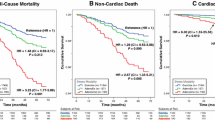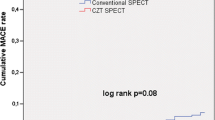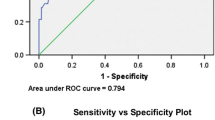Abstract
Background
Regadenoson is now widely used in single-photon emission computed tomography (SPECT) myocardial perfusion imaging (MPI). However, the prognostic value of abnormal stress perfusion findings with regadenoson vs adenosine are unclear. The aim of this study was to evaluate the prognostic value of regadenoson SPECT and to compare it to that of adenosine SPECT.
Methods and Results
3698 consecutive patients undergoing either adenosine or regadenoson SPECT were assessed at 1 year for the endpoints of cardiovascular death and a composite endpoint of cardiovascular death or MI. Weighted Cox proportional hazards regression modeling with the inverse probability weighted (IPW) estimators method adjusting to propensity for agent was used to account for differences in baseline characteristics. Patients undergoing adenosine SPECT MPI had a significantly higher prevalence of smoking history, diabetes, hypertension, and prior myocardial infarction (P < .05, all). At 1 year of follow-up, there were 154 cardiovascular deaths and 204 with the composite endpoint of cardiovascular death or MI. Using IPW adjustment to propensity for agent in a model with stress agent, summed stress score (SSS) remained a significant predictor of the composite endpoint of cardiovascular death or MI (HR 1.36 CI 1.28-1.46; P < .0001) as well as cardiovascular death (HR 1.38 CI 1.28-1.49; P < .0001). The interaction of SSS with agent was not significant. Similar findings were seen with summed difference score (SDS).
Conclusions
SSS derived from either adenosine or regadenoson SPECT MPI is a significant predictor of events and provides incremental prognostic information beyond basic clinical variables. We have shown for the first time that use of regadenoson vs adenosine as stress agent does not modify the prognostic significance of SSS. Similar findings were seen with SDS.


Similar content being viewed by others
Abbreviations
- CABG:
-
Coronary Artery Bypass Grafting
- IPW:
-
Inverse Probability Weighted
- MPI:
-
Myocardial Perfusion Imaging
- MI:
-
Myocardial Infarction
- PCI:
-
Percutaneous Coronary Intervention
- SDS:
-
Summed Difference Score
- SPECT:
-
Single-photon emission computed tomography
- SRS:
-
Summed Rest Score
- SSS:
-
Summed Stress Score
References
Henzlova MJ, Cerqueira MD, Mahmarian JJ, Yao SS. Quality Assurance Committee of the American Society of Nuclear C. Stress protocols and tracers. J Nucl Cardiol 2006;13:e80-90.
Ladenheim ML, Pollock BH, Rozanski A, Berman DS, Staniloff HM, Forrester JS, et al. Extent and severity of myocardial hypoperfusion as predictors of prognosis in patients with suspected coronary artery disease. J Am Coll Cardiol 1986;7:464-71.
Hachamovitch R, Berman DS, Kiat H, Cohen I, Cabico JA, Friedman J, et al. Exercise myocardial perfusion SPECT in patients without known coronary artery disease: Incremental prognostic value and use in risk stratification. Circulation 1996;93:905-14.
Farzaneh-Far A, Borges-Neto S. Ischemic burden, treatment allocation, and outcomes in stable coronary artery disease. Circ Cardiovasc Imaging 2011;4(6):746-53.
Berman DS, Kang X, Hayes SW, Friedman JD, Cohen I, Abidov A, et al. Adenosine myocardial perfusion single-photon emission computed tomography in women compared with men. Impact of diabetes mellitus on incremental prognostic value and effect on patient management. J Am Coll Cardiol 2003;41:1125-33.
Amanullah AM, Berman DS, Erel J, Kiat H, Cohen I, Germano G, et al. Incremental prognostic value of adenosine myocardial perfusion single-photon emission computed tomography in women with suspected coronary artery disease. Am J Cardiol 1998;82:725-30.
Hachamovitch R, Berman DS, Shaw LJ, Kiat H, Cohen I, Cabico JA, et al. Incremental prognostic value of myocardial perfusion single photon emission computed tomography for the prediction of cardiac death: Differential stratification for risk of cardiac death and myocardial infarction. Circulation 1998;97:535-43.
Iqbal FM, Hage FG, Ahmed A, Dean PJ, Raslan S, Heo J, et al. Comparison of the prognostic value of normal regadenoson with normal adenosine myocardial perfusion imaging with propensity score matching. JACC Cardiovasc Imaging 2012;5:1014-21.
Al Jaroudi W, Iskandrian AE. Regadenoson: A new myocardial stress agent. J Am Coll Cardiol 2009;54:1123-30.
Iskandrian AE, Bateman TM, Belardinelli L, Blackburn B, Cerqueira MD, Hendel RC, et al. Adenosine versus regadenoson comparative evaluation in myocardial perfusion imaging: Results of the ADVANCE phase 3 multicenter international trial. J Nucl Cardiol 2007;14:645-58.
Mahmarian JJ, Cerqueira MD, Iskandrian AE, Bateman TM, Thomas GS, Hendel RC, et al. Regadenoson induces comparable left ventricular perfusion defects as adenosine: A quantitative analysis from the ADVANCE MPI 2 trial. JACC Cardiovasc Imaging 2009;2:959-68.
Mahmarian JJ, Peterson LE, Xu J, Cerqueira MD, Iskandrian AE, Bateman TM, et al. Regadenoson provides perfusion results comparable to adenosine in heterogeneous patient populations: A quantitative analysis from the ADVANCE MPI trials. J Nucl Cardiol 2015;22:248-61.
Borges-Neto S, Shaw LK, Tuttle RH, Alexander JH, Smith WTt, Chambless M, et al. Incremental prognostic power of single-photon emission computed tomographic myocardial perfusion imaging in patients with known or suspected coronary artery disease. Am J Cardiol 2005;95:182-8.
Borges-Neto S, Tuttle RH, Shaw LK, Smith WTt, Jain D, Coleman RE, et al. Outcome prediction in patients at high risk for coronary artery disease: Comparison between 99mTc tetrofosmin and 99mTc sestamibi. Radiology 2004;232:58-65.
Salerno M, Elliot L, Shaw LK, Piccini JP, Pagnanelli R, Borges-Neto S. Prognostic validation of an algorithm to convert myocardial perfusion SPECT imaging data from a 12-segment model to a 17-segment model. J Nucl Cardiol 2009;16:605-13.
Austin PC. An introduction to propensity score methods for reducing the effects of confounding in observational studies. Multivar Behav Res 2011;46:399-424.
Cole SR, Hernan MA. Adjusted survival curves with inverse probability weights. Comput Methods Programs Biomed 2004;75:45-9.
Rozanski A, Gransar H, Hayes SW, Min J, Friedman JD, Thomson LE, et al. Temporal trends in the frequency of inducible myocardial ischemia during cardiac stress testing: 1991 to 2009. J Am Coll Cardiol 2013;61:1054-65.
Pijls NH, Fearon WF, Tonino PA, Siebert U, Ikeno F, Bornschein B, et al. Fractional flow reserve versus angiography for guiding percutaneous coronary intervention in patients with multivessel coronary artery disease: 2-year follow-up of the FAME (Fractional Flow Reserve Versus Angiography for Multivessel Evaluation) study. J Am Coll Cardiol 2010;56:177-84.
Dandekar VK, Bauml MA, Ertel AW, Dickens C, Gonzalez RC, Farzaneh-Far A. Assessment of global myocardial perfusion reserve using cardiovascular magnetic resonance of coronary sinus flow at 3 Tesla. J Cardiovasc Magn Reson 2014;16:24.
Greenwood JP, Maredia N, Younger JF, Brown JM, Nixon J, Everett CC, et al. Cardiovascular magnetic resonance and single-photon emission computed tomography for diagnosis of coronary heart disease (CE-MARC): A prospective trial. Lancet 2012;379:453-60.
Abbasi SA, Ertel A, Shah RV, Dandekar V, Chung J, Bhat G, et al. Impact of cardiovascular magnetic resonance on management and clinical decision-making in heart failure patients. J Cardiovasc Magn Reson 2013;15:89.
Lieu HD, Shryock JC, von Mering GO, Gordi T, Blackburn B, Olmsted AW, et al. Regadenoson, a selective A2A adenosine receptor agonist, causes dose-dependent increases in coronary blood flow velocity in humans. J Nucl Cardiol 2007;14:514-20.
Cerqueira MD, Nguyen P, Staehr P, Underwood SR, Iskandrian AE. Investigators A-MT. Effects of age, gender, obesity, and diabetes on the efficacy and safety of the selective A2A agonist regadenoson versus adenosine in myocardial perfusion imaging integrated ADVANCE-MPI trial results. JACC Cardiovasc Imaging 2008;1(3):307-16.
Hage FG, Ghimire G, Lester D, McKay J, Bleich S, El-Hajj S, et al. The prognostic value of regadenoson myocardial perfusion imaging. J Nucl Cardiol 2015.
Acampa W, Salvatore M, Cuocolo A. Prognostication in the era of a new stressor for myocardial perfusion imaging. J Nucl Cardiol 2015.
Disclosures
This was an investigator-initiated study partly funded by Astellas Pharma. The company was not involved in study design, scan interpretation, data acquisition, endpoint adjudication, statistical analysis, or manuscript preparation.
Author information
Authors and Affiliations
Corresponding author
Additional information
See related editorials, doi:10.1007/s12350-015-0179-3 and doi:10.1007/s12350-015-0157-9.
Electronic supplementary material
Below is the link to the electronic supplementary material.
Rights and permissions
About this article
Cite this article
Farzaneh-Far, A., Shaw, L.K., Dunning, A. et al. Comparison of the prognostic value of regadenoson and adenosine myocardial perfusion imaging. J. Nucl. Cardiol. 22, 600–607 (2015). https://doi.org/10.1007/s12350-015-0155-y
Received:
Accepted:
Published:
Issue Date:
DOI: https://doi.org/10.1007/s12350-015-0155-y




